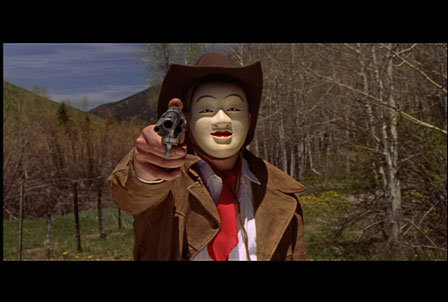Javier Tellez
dal 16/4/2009 al 13/6/2009
Segnalato da
16/4/2009
Javier Tellez
Kunstverein Braunschweig, Braunschweig
4 1/2. Along with installations, the Kunstverein is presenting Tellez's four most important films (La Passion de Jeanne d'Arc, Oedipus Marshall, Letter on the Blind (For the Use of Those Who See), and Caligari and the Sleepwalker), where the artist questions that what we understand by emotional and physical "normality". His work oscillates between fiction and documentation at accustomed socio-cultural boundaries and reinterprets classic material from the stage and screen.

The Kunstverein Braunschweig is presenting the first European
institutional solo exhibition of the New York artist Javier Tèllez
(born 1969 in Venezuela). Along with installations, the Kunstverein is
presenting Tèllez's four most important films: 'La Passion de
Jeanne d'Arc (Rozelle Hospital, Sydney)' (2004), 'Oedipus Marshall'
(2006), 'Letter on the Blind (For the Use of Those Who See)' (2007) as
well as his most recent production 'Caligari and the Sleepwalker' (2008).
Javier Tèllez, who has already participated in numerous
international group exhibitions such as the Biennales in Sao Paulo (1998),
Gwanju (2000), Venice (2001 und 2003), Sydney (2003), the Whitney Biennale
(2008) and, finally, Manifesta 7, tears with his work that oscillates
between fiction and documentation at accustomed socio-cultural boundaries
and reinterprets classic material from the stage and screen. In his
films, the artist questions that what we understand by emotional and
physical 'normality.' As the son of two psychiatrists, Tèllez came
into contact with psychiatric facilities at a young age. 'When I started
visiting museums at that time, I noticed quite a few similarities between
the typologies of both kinds of institutions. Hygienically pure spaces,
long corridors, strained styles and the weight of architecture... Both
institutions are emblematic representations of authority that rely upon
classifications such as 'normal' versus 'pathological' and 'inclusive'
versus 'exclusive'.'
'La Passion de Jeanne d'Arc (Rozelle Hospital,
Sydney)' (2004) is regarded as Tèllez's pathbreaking film
production. The reworked silent film 'Jeanne d'Arc' (1928) and the film
'Twelve and a Marionette', which was shot in psychiatric clinic, are shown
in a double projection. Twelve women speak in very different fashions
about the institutional dealing with their illnesses (depression,
schizophrenia). The juxtaposed projections of Jeanne d'Arc-who was
stigmatized in her day as a possessed person and is now recognized as a
misunderstood visionary and magnificent national hero-place the patients
in a new perspective. These films demand with great urgency a rethinking
of the notions of healthy and ill, normal and abnormal. In the film
'Oedipus Marshall' (2006), Tèllez stages Sophocles' classic
tragedy, Oedipus Rex, with Western costumes and Japanese masks. An
abandoned gold mining town in Colorado served as the backdrop. Using
interchangeable elements from our collective memory, a film came about
which takes up and simultaneously breaks down familiar things. The masks
and maskings in Tèllez's films introduce Meta levels. As ambivalent
elements, they conceal or demystify them; they destabilize personality
boundaries, but also symbolize the facility of psychologically ill persons
for mimicry. 'Letter on the Blind (For the Use of Those Who See)' (2007)
draws on the eponymous classic by Diderot and the Buddhist parable of the
blind persons and the elephant. In the story, the blind persons each feel
only one part of the elephant's body and describe it. Accordingly, their
descriptions of one and the same animal are remarkably different.
The
parable makes us aware of the fact that 'reality' is by no means an
objectively appraisable constant, but defined by our own perception
instead. Tèllez stages the encounter of the six blind New Yorkers
with the elephant in a disused swimming pool. The distinctly individual
voices of the protagonists enable the senses of taste, hearing, and
smelling to come to the fore, while the poetic, black and white images are
silently scaled back. His most recent film, 'Caligari and the
Sleepwalker' (2008), is based on the 1919 Expressionist silent film, 'The
Cabinet of Dr. Caligari.' In Tellèz's interpretation, Dr. Caligari
carries out a kind of therapeutic conversation with Cesare, 'the alien
from the slave star,' who has been in a kind on somnambulist state for
years and can only communicate by means of panels of slate. The mixture of
layers of reality, changes of identity, and polyphony are the themes that
Tèllez's films often deal with contentually, but also realize in
terms of representational techniques. By selecting the Einstein Tower- the
architect Erich Mendelsohn's icon of Expressionist architecture in
Potsdam-as the site of the film, he additionally points to an epoch of art
and film history that dealt for the first time with pathological
disturbances and drew inspiration from it.
A comprehensive, retrospective
catalog-the very first monograph-with texts by Guy Brett, Michele Faquet
and Hilke Wagner (Foreword), among others, will be published on the
occasion of the exhibition.
Oedipus Marshall, 2006, Filmstill. Courtesy: Peter Kilchmann, Zürich | Figge von Rosen, Köln | Galerie ARRATIA, BEER, Berlin
Press contact:
Katrin Meder | Tel. 0531 49556 | meder@kunstverein-bs.de
Opening: Friday, April 17, 2009 at 7 p.m.
Kunstverein Braunschweig
Lessingplatz 12 - Braunschweig
Opening Hours: Tue-Sun 11 am to 5 pm, Thu 11 am to 8 pm



